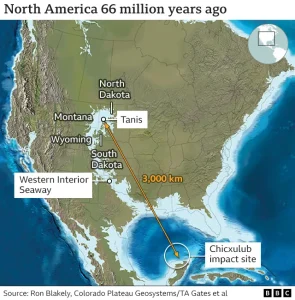Sent in by William. Look at the image. The Interior Seaway is perfectly aligned with Chicxulub. 
At https://www.news.yahoo.com/tanis-first-dinosaur-fossils-linked-210028696.html … the leg of a dinosaur, complete with skin, has been unearthed at the Tanis dinosaur graveyard in North Dakota. The claim is the creatures in the Tanis formation were killed and entombed on the very day the asteroid struck Chicxulub. If that is true there are some questions to ask about the so called North American Inner Seaway – which is strewn with fossils. Was it really a seaway in existence for thousands of years or was it a rush of ocean water from what is now the Caribbean, that swept up as far north as Montana and North Dakota? As it went it drowned and caught up animals in its path, from land and river systems, as well as marine life. The great wave idea is not of course part of mainstream thinking but it is worth remembering the idea of an interior seaway was born many decades before the asteroid strike had been discovered. Not only that, it is known as a seaway because of the uniformitarian dating methodology, in which sediments are laid down slowly over thousands, or even millions of years. Food for thought.
There would of course be some fierce resistance to such an idea, not least by geologists [but see the next post]. It would mean that all that long dating of sedimentary layers both sides of the K/T [K/Pg] boundary event would also have to be reassessed. If these layers were created over a short period of time in the manner of the sedimentary layers that were created in days following the recent Mount St Helens eruption, then the end of the Cretaceous would have to come under the microscope. This does not mean all sedimentary layers were laid down quickly, but obviously some of them were. Particularly at extinction events such as the end of Triassic and the end of Permian. Several other pieces of odd pieces of the jigsaw might also fall into place, such as the timing of the Deccan Traps volcanic outpouring of lava. Did it coincide with the asteroid strike?
Uniformitarian geology, otherwise known as Gradualism, was invented by people who were not really geologists. At least, not in the modern sense. It was, in a way, an insurrection against religion that set out to place strictures on research. The idea of anti-catastrophism was really all about anti-Noah’s Flood. Obviously, humans were not living in the era of the dinosaurs so that hoary old chestnut is no longer an excuse. The trouble is they pulled the plug on all the bath water in order to puncture what they saw as religious interference in science. All kinds of catastrophism went out of the window, as espoused by geologists opposed to Gradualism at the time. Nowadays, most people, not least your average geologist, do not follow any religion – but the idea that the church vociferously opposed modernisation is all part of the curriculum taught at degree level. Some early geologists did combine geology, and other disciplines, with a career in the Church, and they lost out.
Getting back to the link above, and no doubt more links will follow, we learn that the BBC made a programme on the finds at Tanis, introduced by David Attenborough. This will be on TV at 6.30pm on Good Friday. It is bound to capture the attention of a lot of people as Easter is usually full of repeats and old films. That I suppose was the idea of screening it on that day. It will include discoveries of small animals, including mammals and their burrows, and the embryo of a flying dinosaur inside its egg, as well as what looks like a fragment of the impactor itself [that sailed all the way up the Interior Seaway]. Tanis is 3000km from the Yucatan. In addition, the remains of animals and plants seem to have been rolled together into the sediment dump in North Dakota, by what is described as ‘waves of river water’ rather than a huge tsunami. Aquatic organisms are mixed in with land based creatures, an exotic cocktail of bits and pieces of mainly disarticulated bone and skin and soft body parts. Sturgeon and Paddlefish in the tangle are key, it seems. They had small particles stuck in their gills. These are spherules of molten rock kicked out by the impact. The fish seem to have breathed in the particles. The spherules have been link chemically and by radiometric dating to Chicxulub. Two particles were also retrieved from tree resin and also identified as having an origin in he impactor – asteroid or comet.
Some geologists were no doubt miffed at the first reports, and some still have reservations about the claims. The story broke in 2019 in the New Yorker magazine, not exactly the way science usually works. However, since then peer reviewed articles have been published – and more are in the pipeline.
The BBC called in outside consultants to examine some of the finds. This included Paul Barret from the London Natural History Museum, a dinosaur expert. The dinosaur leg was not feathered like some of them but was scaley, like lizards. The leg looks like it had been viciously ripped off very quickly, and the animal probably died instantly. The big question is – did it die when the asteroid struck the Yucatan, at Chicxulub? The Tanis team are convinced it did – and they have a graveyard that was clearly formed by a cataclysmic event.
